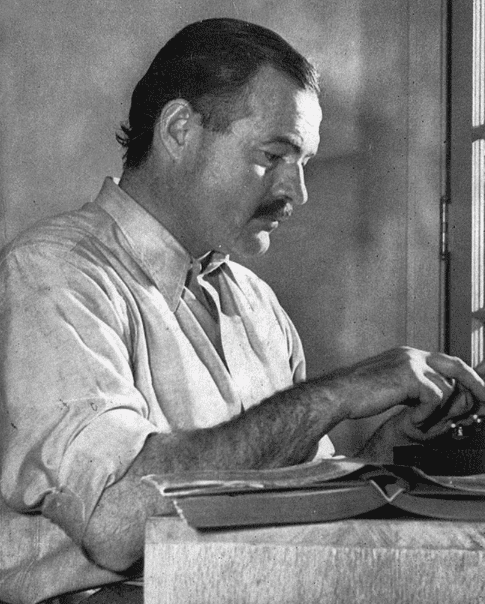Philip R. Liebson
Chicago, Illinois, United States
 |
| Ernest Hemingway, Nobel Prize for Literature, 1954. GPA Photo Archive. Via Flickr. CC BY-NC 2.0 |
Considering Ernest Hemingway’s mishaps before he died in 1961 by a self-inflicted shotgun wound, it is surprising that he lived so long. He survived two plane crashes several days apart that left him with a concussion, burns, cracked ribs and vertebrae, and ruptures of the liver, spleen, and kidneys. Over his lifetime he had nine documented concussions. Once, in Paris, he accidentally pulled a skylight cord too hard thinking it was the toilet flusher, and the whole fixture fell on his head, leading his friend Ezra Pound to write him: “Haow the hellsufferin tomcats did you git drunk enough to fall upwards thru the blithering skylight!!!!!!!”
He courted danger and was wounded as an ambulance driver on the Italian front in World War I, as an observer on the Republican side in the Spanish Civil War, and as a war correspondent during World War II. During the war he hunted Axis submarines in the Caribbean with his boat, albeit half-heartedly, and while a war correspondent with the American forces in the Hürtgen forest, actually participated in combat. His heavy drinking could have been reason enough to debilitate him. Besides these conditions, he had severe heart disease, hypertension, diabetes or at least pre-diabetes, and chronic depression. He was treated for depression with electroconvulsive therapy, and treated for arthritis, heart disease, hypertension, diabetes, liver disease, alcoholism, and general body pain. For the latter he drank concoctions of gin, tomato juice, champagne, and Angostura bitters. His repeated concussions probably led to chronic posttraumatic encephalopathy, which is associated with neurofibrillary tangles and deposits of beta-amyloid in the brain such as those as found in patients with Alzheimer’s dementia.
Many in his family died by suicide, including his father, grandfather, sister, brother, and granddaughter. Yet research about his family background after his death provided by more recent medical discoveries suggest that hereditary hemochromatosis may have been responsible for his mental and physical conditions.
Hemochromatosis is associated with increased absorption of iron, which eventually causes damage to organs such as the liver, pancreas, and heart from excessive iron storage. It is known as the Irish or Celtic curse because of its prevalence in people of Irish and English ancestry. Hemochromatosis is not as rare as previously believed. In Ireland, one in 83 people carry the gene for hemochromatosis. Swiss scientist Sebastian Dieguez wrote in a 2010 journal article that Hemingway’s recorded behavior and symptoms were misdiagnosed and that his death was not an accident, but a suicide driven by the pain of untreated hemochromatosis.
It is speculation that Hemingway suffered from hereditary hemochromatosis, and little was known about its genetic properties at the time of his death. This state leads to heart disease and diabetes and is associated with depression, memory loss, and a bronzing of the skin. Hereditary hemochromatosis may not become apparent until people are in their fifties or sixties. Expression of the disease is influenced by alcohol intake and the ingestion of iron-containing foods and medications. Hemingway’s symptoms and findings were similar to his father’s, who also suffered from diabetes and depression and whose skin turned bronze later in life, suggesting some of the findings of hemochromatosis.
Phlebotomy remains the mainstay of treatment for hereditary hemochromatosis and may take two to three years to adequately reduce iron stores. Serum ferritin levels are used to evaluate residual iron stores. Hemingway could have been easily treated for this condition had his physicians evaluated his plasma iron levels. There is evidence that these levels were evaluated late in his life.
The psychiatrist Andrew Farah published a forensic examination of Hemingway’s condition in the book Hemingway’s Brain, published almost sixty years after his death. This account appears to exclude the possibility of hemochromatosis because Hemingway would have had a serum iron level and possibly an iron-binding capacity checked during his two examinations at the Mayo Clinic in 1960 and 1961. The diagnosis was apparently rejected, and although his primary physician may have considered it, no liver biopsy was performed because of the possibility of fatal hemorrhage.
It is then more likely that Ernest Hemingway developed dementia primarily from his many brain injuries, use of alcohol, hypertension, and diabetes. His blood pressure levels were sometimes as high as 250/125, which could have led to microinfarcts of the brain.
The intriguing question is perhaps not why Hemingway died at the age of sixty-one, but how he managed to survive for so long with his clinical condition and his repeated threats to shoot himself, which he had declared at least as early as 1936.
References
- Crownover, BK and Covey, CJ. “Hereditary hemochromatosis.” Am Fam Physician, 2013: Feb 1; 87(3):183-90.
- Dieguez, S. “A man can be destroyed but not defeated: Ernest Hemingway’s near-death experience and declining health.” Front Neurol Neurosci, 2010, 27:174-206.
- Farah, A. Hemingway’s Brain. Univ of South Carolina Press: Columbia, South Carolina, 2017.
PHILIP R. LIEBSON, MD, received his cardiology training at Bellevue Hospital and the New York Hospital Cornell Medical Center, where he served on the faculty for several years. A professor of medicine and preventive medicine, he has been on the faculty of Rush Medical College since 1972 and held the McMullan-Eybel Chair of Excellence in Clinical Cardiology.
Highlighted in Frontispiece Volume 14, Issue 1 – Winter 2022
Summer 2021 | Sections | Literary Essays

Leave a Reply